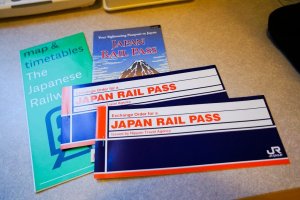Getting ready for your first trip to Japan? Once you have your luggage packed and your tickets booked, be sure to check our list for a few more essentials in getting fully prepared for Japan. These ten tips can make your trip much more enjoyable, so have a quick look and get ready to adventure like a pro!
1. Travel far with a JR Rail Pass
This is literally your ticket to easy transportation in Japan. With a few small exclusions, this pass allows you to ride on all JR-owned transportation including buses, the Shinkansen (bullet trains), and the ferry to Miyajima. The pass is valid for a consecutive duration of one week, two weeks, or three weeks, and gives you full access to Japan in a way that won’t strain your wallet. The JR Rail Pass can only be used by short-term visitors, which makes it perfect when you’re hitting Japan for vacation. f Be sure to purchase the JR Rail Pass before you come to Japan and trade the pass voucher for a physical pass at any major JR station or international airport.

2. Stay connected with a Mobal SIM Card
When you’re traveling in Japan, you will want a reliable and fast internet connection! Instagram, messaging, navigation, checking reservations—your mobile device can do it all . . . so long as you’re connected. That’s where a Japanese SIM card comes in. Mobal is a SIM-card provider that offers short-term SIM cards - an indispensable service. If you’re in Japan for less than 90 days, you will definitely want to have their SIM card delivered to you before you leave; you can also pick it up from a collection point in Japan after you arrive. Whatever plan you choose, Mobal and their English-speaking customer support make it easy to stay connected.
To find out more about what you’ll need in order to use a Mobal SIM card, check here.
3. Go places with an IC Card, like Suica
IC cards act as a type of pre-charged debit card and are handy little cards to keep on you—even if you have the JR Rail Pass—because it can cover anything from transportation fares, convenient stores, select restaurants, and even vending machines! Getting an IC card is easy: simply find a ticket machine at the station. In Tokyo, you can look for the Suica or PASMO branding, but other cities will have their own types of cards that work just as well. All major stations are bound to have them.
For a more in-depth guide on Suica, check here.

4. Take care of your tattoos and smoking habit
If you have a tattoo and visit Japan, you may have a few difficulties at times. Japan has a deep-rooted connection with tattoos due to them being common among the older generation of yakuza, or Japanese mafia; while views are changing in recent years, many places may still be off limits for inked visitors to Japan. Onsen and hot springs especially are often restricted unless you use a tattoo cover-up patch—some hotels and restaurants may also refuse service to tattooed guests.
You can check for tattoo-friendly establishments here.

You should avoid smoking on the streets, as it can land you with a serious fine; find a smoking booth, many of which are located outside train or metro stations. Some restaurants, especially Japanese pubs, still allow smoking inside. Oddly enough, eating while walking is also frowned upon, but only because it’s considered rude (unless you’re at a festival).
5. Make sure you've got the money
Cash is still the reigning king of Japan, where the currency is the Japanese yen. Despite the country slowly shifting to credit card, touch-based and digital payments, many rural establishments still accept only cash. You’ll want to keep cash on you at all times so you don’t get caught unawares, and you’ll definitely want a way to get more when you run out. That’s where Japan's ATMs are your friend, most notably those at 7-Eleven. You can easily withdraw money from most foreign credit cards (and with English support) from any 7-Eleven ATM. Sadly, most other ATMs do not offer foreign credit card support, so do be careful.

6. Navigate the train system with ease
Getting around in a foreign country can be a stressful trial to overcome—or it can be a piece of cake. Let’s make it easy, shall we? Hyperdia is a great place to start when you’re looking up fares, ride times and where to transfer. It’s also available on Apple or Android. By this time, you hopefully have either your JR Rail Pass or Suica card (or both) and can bypass purchasing a ticket, but if that’s not the case, it’s easy! Rather than trying to find your station on the dizzying map above, purchase the lowest priced ticket and adjust your fare after you’ve ridden the train—there’s a fare adjustment machine before you exit the ticket gate.
For some more great advice and tips on riding the train, check out these articles.

A Guide to Riding Trains in Tokyo
Everything you wanted to know (and more) about riding trains in Tokyo.

7. Book a Shinkansen ticket like a pro
The Japanese Shinkansen trains are one of the fastest trains in the world and a unique Japanese experience in their own right. The bullet train is a great way to cross long distances in Japan and can be a sightseeing extravaganza. With the handy JR Rail Pass, you get free access (excluding the Nozomi and Mizuho trains). Otherwise, you’ll need to buy a ticket at either the ticket kiosk outside the gate or at the JR Ticket Office (Midori no Madoguchi). There are reserved tickets (“shitei-seki”) that are available for a small additiional fee, and non-reserved seats (“jiyuu-seki”). When booking your ticket, you’ll be able to select which type you want. Once you have a ticket in hand, it’s as easy as finding your car and seat number and lining up for the train!
You can also book Shinkansen tickets online, here.

8. Survive that airport crawl
Going to and from the airport can be a nightmare in any country, let alone one where you may not speak or read the language. Thankfully, these days, the airport has plenty of English signage to help you find your way. Aside from the usual flying and boarding guidelines, here are a few more tips:
- Stay hydrated during the flight—chances are you’re coming from far away and, trust us, you’ll need the water.
- Use one of the same-day luggage delivery services found at the airport—it takes away a lot of stress when you don’t have to lug around a suitcase the first time you board the trains. Yamato is easy to find and easy to use.
- Take the train or limousine bus—taxis are great but they are not the most cost-effective way to get from the airport to wherever it is you’re going.
And remember, as cool as your replica swords or ninja stars may be, on the way home they have to be stored in checked-in luggage.

9. See more of Japan on two wheels
Using a bike can actually save you both time and money, not to mention show you more sights than the inside of a train. In the big cities, it can be true that it’s faster (and more cost-effective) to walk one or two stops than to ride, but who wants to tire themselves out on vacation? Rental bicycles are easy to access in many cities, and some hotels and hostels even offer their own bicycles at an additional cost to guests. Having a bicycle at your disposal can give you more flexibility in your travel plans than you might find true of using public transportation, and it’s definitely eco-friendlier. Why not give cycling a go while you’re in Japan?
You’ll find more information on where to rent a bike over here.

10. Don't forget to take along some basic Japanese
Whenever you travel to a foreign country, it’s always a good idea to know a few phrases of the local language—things are no different in Japan. While many tourists have an image of Japanese people being fluent in English, you may find that they’re shy to speak up. Breaking the ice with a nice “Sumimasen” (Excuse me) can make all the difference.
Here’s a list of handy survival phrases that are easy to remember.
There is also a never-ending supply of translation programs and apps and electronic dictionaries if you’d like to choose that route. Google Translate is easy to use and available on Apple and Android.
Additionally, some restaurants have English menus and many have pictures. One recommendation though—if you have any allergies, know those words in Japanese so you can tell people about your allergy (arerugii).

You're ready to take on Japan! Go out there and have an adventure!






























